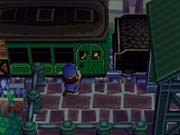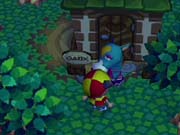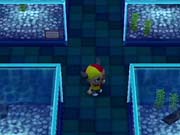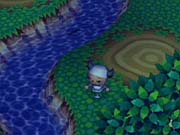Animal Crossing Preview
Find out what to expect from Nintendo's life simulator when it's released in North America later this year.
During the Nintendo 64 and PlayStation era, you would have never seen a game like Animal Crossing being released in the US. But now that Pikmin, another quirky game, has enjoyed moderate success here, it seems like the floodgates may have opened. First Eidos started its own wing to release Japanese games like Ka, a mosquito simulation, and then Nintendo went on record to state that Animal Crossing would be released in the Western Hemisphere. When you have a console that's just a few months old competing against another platform that's been on the market an extra year, sometimes it's necessary to pull out all the stops. And that's exactly what Nintendo has done in deciding to bring this strange life simulation to Western shores.

More of an experience than a game, Animal Crossing places you in the roll of the new guy in town. As the game begins, you hop off a train and take up residence in a small village aptly named Animal Crossing. After naming your character, giving your town a name, and choosing your abode, your goal is to forge some sort of life and coexist peacefully with the other citizens of the village. In other words, there's really no objective at all. Instead, the pleasure in playing Animal Crossing comes from the same types of things that humans gain pleasure from in real life: accomplishments, surprises, and the feeling of working together to make things better.
The first thing you'll notice while playing Animal Crossing is that the game is governed by the GameCube's internal time and date. Because of this, every game starts out differently depending on the time of the year. The Japanese version of Animal Crossing comes packed with a memory card that contains code that will make sure each time playing the game is different. Nintendo hasn't stated if this will be the case for the game's US release. After you get off the train at the game's outset there's a small village just south of the train station where you may choose your house. Several players can play the game at a time, all of them living in this same little neighborhood. When the game begins, your house is empty save for a boom box and a journal. You'll eventually use the radio to play music that you acquire throughout the game, and the journal will help you keep track of all the events in the game such as when relatives are planning to visit or when specific characters show up in the village.

One of the few objectives in the game is to get your house outfitted with furniture and many of the other niceties of life. You can purchase items, while other times they'll simply be given to you. You can also trade objects with other people playing the game. Outside your house is a mailbox where you can receive letters from loved ones and gifts at the appropriate time of the year. If you talk to the right people you will receive video games in the mail during Christmas and other nice surprises. On the other side of the house is an animated object that resembles a fire hydrant. The hydrant serves a number of purposes--it's where you save the game and deposit items once your character's inventory is full, and it's where you can choose the color for the portal on the front door of your house. The hydrant also gives you the option of selling items that you've collected throughout the game.
It's not hard to tell by now that Animal Crossing is primarily a collecting game, and there's a wide variety of objects you can add to your house to give it a personal touch. You can acquire chairs, rugs that will change the textures inside your house, a Famicom, and much more. But to acquire items you'll have to work for them, and at the game's outset you're forced to take a job at a local shop. Initially the jobs range from planting foliage to taking items to specific locations within the village. After you've paid off the debt for your home, you'll be taking jobs from everyone in the village, hoping to make your life and home better. Eventually, the items you have in your house and how they are laid out will be rated by a committee, so it's important to make sure your house is stocked with items that do not come easily.
Playing Animal Crossing is very easy. You control your character's movements with the analog stick, and the A button is used to grab hold of objects in your house and move them or to shake trees while outside. Shaking trees can result in several different outcomes. Sometimes only leaves will flitter down to the ground, but other times you're rewarded with surprises. Money bags or fruit will occasionally fall out of the trees and can be picked up with the B button, but if you shake the wrong tree, a swarm of bees will sting you and give you a swollen eye. While the village isn't overly large, using the R button allows your character to run. You can always access your inventory with the Y button, and once you've acquired it, a map of the village is accessed with the X button. Eventually you'll acquire a spade that will let you dig into the ground looking for treasure. If you look on your map, you'll see designated dig spots that will reward you with special items.

What really sets Animal Crossing apart from other games is its random nature. Events seem to take place independently of your character's actions, and you never know what's going to happen each time you play. There are fishing competitions, musicians performing music at specific times, Christmas celebrations, a New Year's countdown, workouts, and much more. There's also the ability to connect your Game Boy Advance to the GameCube to download a small handheld version of the game to the handheld's RAM. Nintendo had demonstrated at Space World last year the ability to design your own textures on the Game Boy Advance and import them into the GameCube game, though we were unable to find this feature in the build we played. There's even a secret island that can be uncovered when the Game Boy Advance is connected to the GameCube. In all, there's not much action in Animal Crossing, and the adventure relies heavily on text bubbles to keep the game going forward. Fans of action games will likely not enjoy it, but collectors or those who enjoy discovery in video games will likely adore it.
Animal Crossing started as a Nintendo 64 game, and its obvious when viewing the game's graphics. Few polygons are shown onscreen at a time, and the main character features a very simple design. While you can change your character's appearance by acquiring new clothes, it's hard to look past the fact that it's constructed of about 100 polygons. But the game does manage to have its own visual style, and what really sets its graphics apart from other games is that the village is constantly changing. Fruit will appear on trees, the foliage will change with the seasons, and characters will come and go. There is also a shift from daytime to nighttime. In this sense, the game is truly effective at conveying the passing of time.Real-time cinemas are used in conjunction with text bubbles to move the story forward, but facial animation is not a part of the question, and there's no way to skip past these scenes. You can always use the C stick to zoom in and get a better look at things, but this only shows off the game's textures, which are of Nintendo 64 quality. As you might have guessed, the entire village is filled with animals, but none of them look any better than the playable character. Particle effects, lighting, and other graphical niceties are nowhere to be found, and those who have problems enjoying visually challenged games would do well to stay away from Animal Crossing.

There is no voice work included in the game. Instead, the animals spew out gibberish as in games like Banjo-Kazooie. The music can be quite soothing with its relaxing tempos and jazz drums, and you may even create your own music that will be played back during the game. Like the graphics, the sound gets the job done with no frills and primarily stands as a backdrop to the game's ambitious design.
Like The Sims, Animal Crossing will appeal to players who enjoy a more laid-back experience from their video games. It's definitely not for everyone, but collectors will enjoy the wide variety of housing options available, and the game's ability to allow several people to populate the village at once will make it popular with families or groups of friends. Fans of graphics-heavy action games will definitely be put off by Animal Crossing's passive gameplay and simplistic looks, but those who enjoy interesting game design would do well to keep an eye on it. Animal Crossing is currently scheduled for release at the end of the year. Look for more on the US version of the game in the near future.
Special thanks to Mark Green for menu translation.
Got a news tip or want to contact us directly? Email news@gamespot.com
Join the conversation